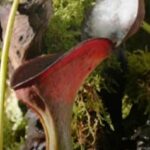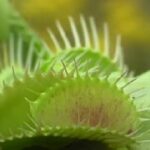As an Amazon Associate, this site earns commissions from qualifying purchases. For more details, click here.
Like other plants, the pitcher plant can photosynthesize and make glucose. So why does it eat insects? Why did these plants develop traps when they are capable of producing their own food? The answer is simple.
Pitcher plants eat bugs because they grow in nutrient-poor soil. Insects contain amino acids, iron and other micronutrients which these plants need.
Why Pitcher Plants Eat Bugs
The simplest way to think of this is that glucose is food and insects are nutrients. Pitcher plants use both for growth, strengthen their immune system and stay healthy.
Take humans for example. We eat food to nourish ourselves and stay healthy. Many of us also take multivitamins to supplement our diet.
If your diet lacks vitamin C for example, you can take vitamin C supplements. Same with protein, iron and other nutrient deficiencies you may have.
We can survive without multivitamins if we consume enough nutritious food. But if we lack certain vitamins and minerals, these supplements will fill the gap.
This analogy is applicable to pitcher plants. While plants do not eat food the way humans do, the comparison in this case is applicable.
Photosynthesis vs. Insect Nutrients
Part of the confusion is that glucose and insects are both called pitcher plant food. So let’s take a close look at both, their similarities and differences.
Photosynthesis. Pitcher plants produce glucose through photosynthesis. Glucose is used for cell division, protein synthesis and as substrate.
Glucose is also used to construct cell walls and produce other types of plant food.
In other words, pitcher plants use photosynthesis for basic, essential functions. Photosynthesis and glucose are necessary for these plants to survive.
Insect Nutrients. So if pitcher plants produce their own food, why bother eating bugs? Because carnivorous plants gain a lot from them.
Aside from glucose, pitcher plants also benefit from amino acids, iron, protein and other micronutrients.
These nutrients are usually found in the soil. What happens with most plants is the nutrients are absorbed by the roots along with the water, nourishing the plant.
But pitcher plants only grow in boggy soil with little to no nutrients. The soil is so poor that non-carnivorous plants cannot survive there.
Because the soil lacks nutrients, pitcher plants have to look elsewhere. It just so happens that insects have the nutrients that these plants need.

When Did Pitcher Plants Start Eating Bugs?
Pitcher plants adapted and evolved in their environment. To attract bugs, these plants developed traps to lure their prey.
In spite of the harsh habitat, pitcher plants managed to adapt and thrive. Today, these plants are so accustomed to getting nutrients from bugs that they won’t survive in rich soil.
We don’t know how long it took for pitcher plants to develop traps. But we do know these plants managed to carve a niche in a tough environment.
Now they can take advantage of these nutrients without competition since non-carnivorous plants cannot grow there. Pitcher plants can also take advantage of light and water since there are fewer plants in the area.
So even though pitcher plants grow in poor soil, adding insects to their diet more than makes up for it.
Should You Feed Pitcher Plants?
Outdoor pitcher plants do not have to be fed. They will lure bugs and all kinds of insects into their traps. You will almost always see a bug or two in the plant no hand feeding is needed.
Indoor pitcher plants should be fed every 2-3 weeks. Catching live bugs can be a challenge, but these plants will eat dead ones too.
Aside from insects, you can also give them mealworms. I prefer Soil Sunrise Mealworms because it contains nutrients that are similar to insects, if not more.
Pitcher plants also eat fish food like Tetra Betta. I prefer to mix and match the food so sometimes I give my plants insects, other times fish food or mealworms.
Nepenthes and sarracenia eat all kinds of flying and crawling bugs. Flies, spiders, crickets, mosquitoes, grasshoppers etc. all are food for pitcher plants. You can also drop a few fertilizer pellets in the plant once a month.
How to Feed Pitcher Plants
Decide what you want to feed it. Grab the food with tweezers or your hand and drop it in the pitcher.
Repeat the procedure for each pitcher. Do not fill the pitcher, just one insect is fine. If feeding fish food, just a small amount is enough.
Pitcher plants only need to eat every 2-3 weeks. Keep an eye on the pitcher if you are feeding it something new. As long as it is fish food or mealworms the plant should digest it.
Feeding pitcher plants is easy. But there are some things you should always bear in mind.
- Do not overfeed the pitcher.
- Do not put food in the soil. Whether it is bugs, fish food, mealworms etc. Never leave any of that in the soil because it could harm the plant.
- Do not give pitcher plants insects with hard shells. Beetles for example, have a hard exoskeleton which the plant might have trouble breaking down. This is why I prefer mealworms because it is easier for pitcher plants to consume.
What Not to Feed Pitcher Plants
Do not give human food to pitcher plants. Stick with small insects only, as large bugs can damage the plant.
Slugs, cockroaches and caterpillars should only be given to large pitcher plants. Small and medium sized pitcher plants are at risk because these creatures can tear or eat the plant.
I would also avoid giving large, live worms to these plants because they too can eat through the leaves.
Do not give processed food to pitcher plants. Hamburgers, hotdogs, ham, chicken are a no-no. Pitcher plants cannot eat cheese, donuts, chocolate, beef or pasta.
I would not give mice to them either. Yes some pitcher plants can eat mice, but only if the pitcher is large enough. Personally I wouldn’t give my plants anything that big.
Will Pitcher Plants Die without Bugs?
Pitcher plants can live without insects if there is enough light. However, the plant will not reach its maximum growth potential.
To reiterate, glucose is pitcher plant food and insects are nutrients. Both are essential for them to grow and stay healthy,
But pitcher plants can survive without eating bugs. Nutrients from insects are important, but if there is enough glucose the plant will live.
But don’t expect pitcher plants to thrive, because all the resources will focus on the bare essentials. But if we are talking about survival, then yes.
Why is My Pitcher Plant Not Eating?
The most likely reason is lack of light. Without enough light, pitcher plants will weaken and lose appetite.
As explained earlier, pitcher plants use photosynthesis to produce their own food, glucose. It’s the energy they get from glucose that allows them to digest insects, so they complement each other.
Even if your pitcher plants get plenty of light, nutrients from insects are still needed to make up for the poor soil. Do not use rich soil because it will hurt or kill the plant.
Related. How do you keep pitcher plants alive?
Besides insufficient light, there are other reasons why a pitcher plant may refuse to eat.
Overfed. Pitcher plants need 1-2 weeks to digest food, which is why they should only eat every two or three weeks.
Pitcher plants use up energy to consume food. If you feed it every day, it won’t be able to fully digest everything.
If you just fed the pitcher yesterday and dropped a few more today, don’t be surprised if the bugs are not eaten. It takes time to digest these.
Dormant. Sarracenia pitcher plants go dormant in winter and will not eat. Dormancy lasts 3-4 months so don’t expect the plant to eat during this period. Nepenthes are tropical pitcher plants and do not require dormancy.
Pest or disease. Root rot occurs due to too much water, fungi in the soil or inadequate drainage. Check also for signs of aphid infestation or spider mites.

My fascination with carnivorous plants began many, many years ago with Venus Fly Traps. Now I am more than happy to impart what I know with other enthusiasts and those who are curious about meat eating plants.


